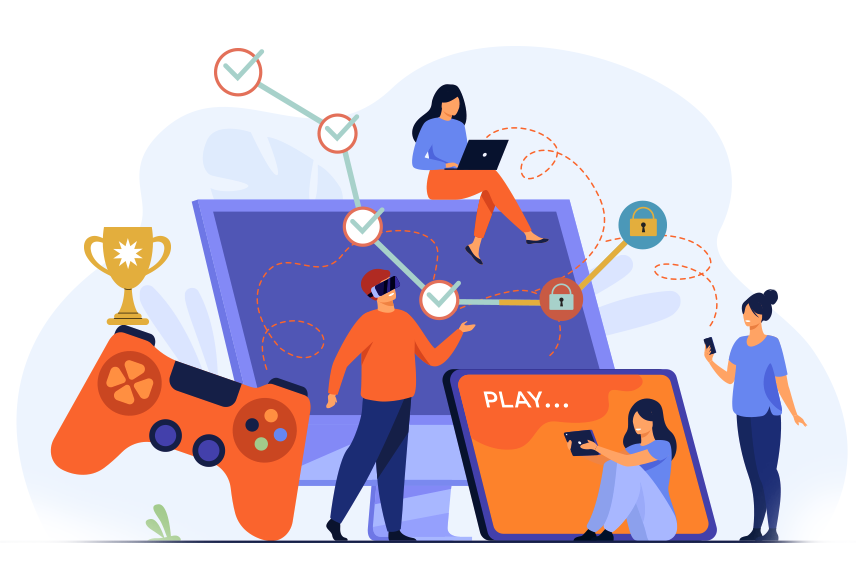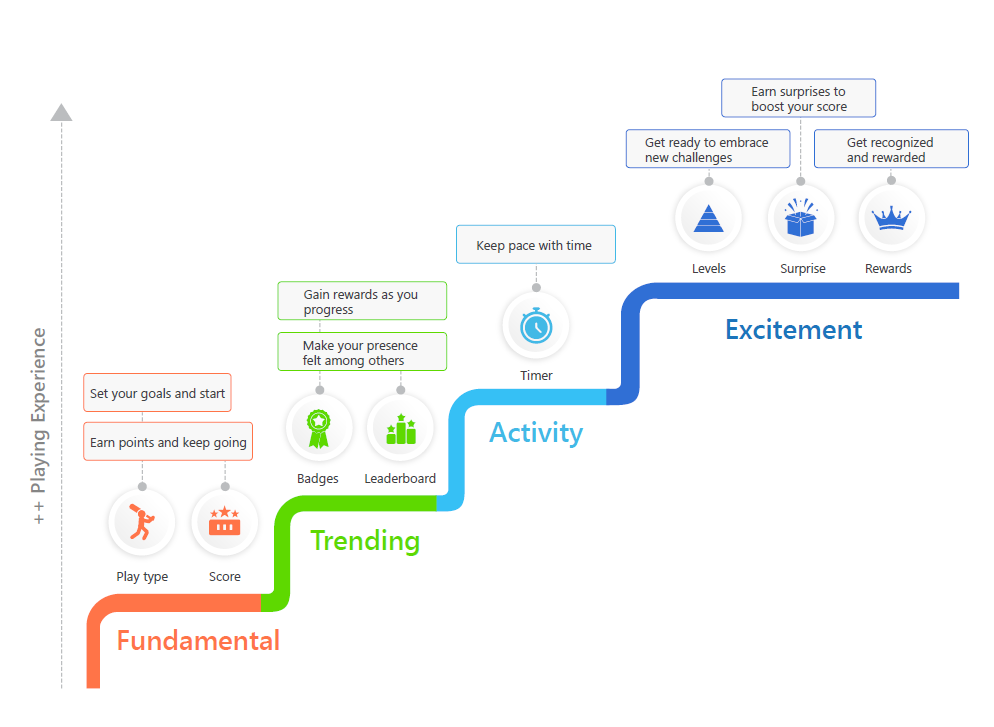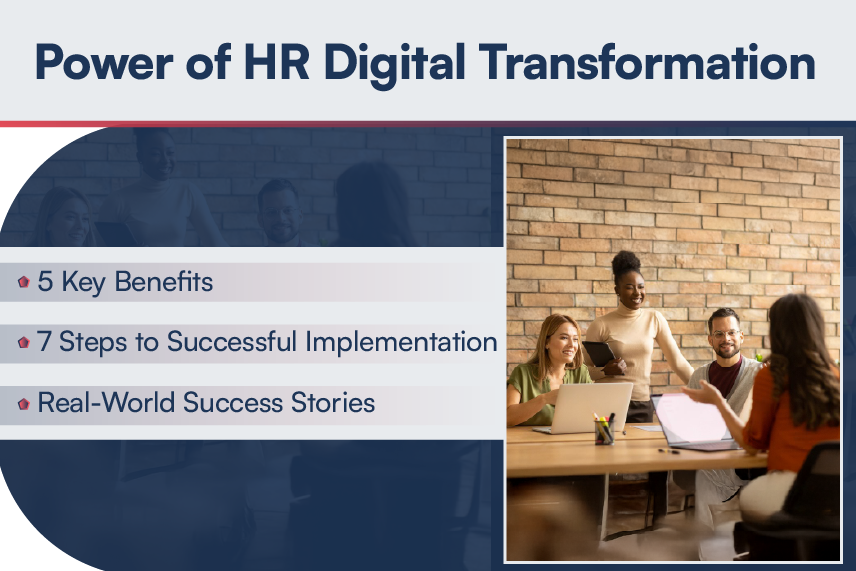
Table of Contents
Gamification in eLearning is a technique that can go a long way, as professional trainings are not limited to instructor-led classroom sessions anymore. Since, eLearning in the corporate world is revolutionizing the way, people skill, upskill, and cross-skill, gamification in eLearning is taking over the space by adding elements like engagement, thrill, sense of victory and more.
Gamification in eLearning indeed is one of the most pioneering and unconventional ways of training employees in a more intriguing and interesting way. It adds the fun factor to the entire process. However, it can be a great platform to encourage employees to take up learning and re-learning with great levels of enthusiasm.
What Is Gamification?
Gamification is the addition of game mechanics to a user interface using marketing or instructional content. It is a method of repurposing information that takes advantage of game motivations. Gamification, according to Dr. Joshi is the application of gaming aspects to a process that is otherwise mundane. The core purpose of gamification is to increase involvement and improve outcomes.
Gamification has gained a lot of traction because of the Internet and other new technologies. Even learning & development leaders (L&D) have taken notice of this. Everyone is probably more familiar with gamification than they realize. Even if it isn’t immediately acknowledged, it is already a common practice. And there are several reasons that prove why gamifying eLearning should matter to any company whose primary goal is to improve employee satisfaction and engagement.
Benefits Of Gamification in eLearning
The role of gamification in eLearning is rapidly increasing as it is proving to be a great tool in enhancing the learning experience. For instance, wouldn’t a scenario-based game be more fun to complete rather than a couple-of-questions-long MCQ quiz as part of an onboarding process?
According to a recent study by MarketsandMarkets, the gamification market size in 2020 had a global value of $9.1 billion and is predicted to register an impressive growth rate of 27.4%, reaching $30.7 billion by 2025. No wonder gamification is one of the top 10 must-have features of a learning management system (ProProfs, 2021).
Gamification creates an informal setting where a learner is motivated to explore a topic with an open mind. Here are the top 5 benefits it results in:
1. Increased learner engagement – Any learning content will have specific goals. Unless the learners are excited about knowing more, the objectives cannot be accomplished. On the contrary gamification elements in eLearning can be leveraged in a course to challenge the learner to think, explore, and eventually increase the engagement level.
2. Better feedback mechanism – Game-based learning allows educators to provide unique ways of giving feedback to the learners, which is essential for understanding the performance curve. It also helps in identifying the knowledge gaps.
3. Improves knowledge retention – Gamification in eLearning makes knowledge absorption easy. The game dynamics improve productivity, making the environment conducive to retaining information.
4. Creates a framework for microlearning – Simplifying the content into nuggets is an attractive and easy way of learning large portions of the content. However, implementing custom eLearning gamification techniques can intrigue a learner to pick up information bites, thus keeping them motivated to learn more.
5. Promotes learning culture – This benefit is especially true in the case of using gamification for the recruitment and onboarding process. Gamification can increase participation among fellow employees and help them bond right at the start.
Gamification has enabled eLearning to become more creative. The design can have surprise elements to up the curiosity quotient for the learners. For a corporate trainer, it can have real-life scenarios to check employee responses. All in all, gamification in eLearning has elevated the digital learning process for learners of all ages and groups. Of course, there do exist some challenges while implementing gamification in eLearning and it would only be fair to take cognizance of those as well.
Challenges Of Gamification in eLearning
"Gamification is the use of game elements and mechanics in non-game contexts, such as eLearning, to enhance engagement and motivation.”
While gamification has the potential to make eLearning more enjoyable and effective, there are several challenges that need to be considered. Here are some of the challenges of gamification in eLearning:
- Designing effective game mechanics: The game mechanics used in gamification must be carefully designed to align with the learning objectives. The challenge is to make the game mechanics challenging and enjoyable while ensuring that they reinforce the learning goals.
- Avoiding superficial gamification: Simply adding game elements to eLearning without a clear learning goal or purpose can be counterproductive. Gamification should be used to enhance the learning experience, not just to make it more entertaining.
- Overcoming learner disinterest: Gamification may not appeal to all learners. Some may find the game mechanics distracting or even irritating. Gamification must be designed with the learner in mind, considering their preferences and learning style.
- Balancing engagement and learning: While gamification can increase engagement, it must be balanced with the learning content. If the game mechanics become too dominant, they may detract from the learning objectives.
- Measuring effectiveness: It can be challenging to measure the effectiveness of gamification in eLearning. Metrics such as completion rates, engagement levels, and assessment scores may not fully capture the impact of gamification on learning outcomes.
- Keeping up with technology: As technology evolves, so do the possibilities for gamification. Keeping up with the latest trends and tools can be a challenge for eLearning developers and educators.
Overall, gamification in eLearning can be a powerful tool. However, it must be used strategically and thoughtfully to ensure that it supports the learning objectives and engages learners in a meaningful way.
The Fundamentals of Gamification in eLearning to Meet Enhanced Learning Experiences

Do you think you can finish reading it under 10 minutes? Only the most efficient readers can. Are you one of them? Let’s find out.
Your time, starts…..NOW!
The Fundamentals of Gamification in eLearning I’m not serious, of course. But rewind the clock ten seconds, and honestly think for a moment—wasn’t there a part of you that had all but readied itself to read this article at a speed fast enough to put a bullet to shame? I’m willing to bet that there was. Thanks to the incredible human impulse of rising to a challenge; to reap its rewards or even to simply bask in the glory of having ‘bested’ it. It is this very human impulse that gamification taps into and makes any banal process engaging and much more compelling.
Now, much has already been documented on the myriad benefits of gamification, including statistical data proving that gamification dramatically improves learner motivation and knowledge retention. So, instead of trying to make the sale for gamifying your training, let us explore the actual process of how best to achieve that.
Know Your Audience
All the exemplary statistics of gamified learning notwithstanding, any gamification strategy is not guaranteed to work across all learner demographics. A sound gamification strategy must thus start with knowing and understating the target audience. Factors like their average age, job profile, technological proficiency, and even cultural considerations play a critical role in selecting the right solution.
Consider the Content
Besides the target audience, the right gamification strategy largely depends on the knowledge material or content. While it has become a common practice to turn the content into your average scored and/or timed assessment questions, albeit packaged into a fancy gamified activity, not all types of content can be or even should be treated as such. In some cases, the content may warrant multiple viewings, revisions, and being largely retained in its original format. An alternative, in such cases, could be gamifying eLearning pathway, or in other words, the progression of the learner as they navigate through these materials. It is never a good idea to try and fit the content into a pre-determined gamification strategy. Rather, the content itself must dictate what strategy would be right for it.
Introduce Choices
Pre-packaged gaming routines tend to be too familiar, resulting in learners losing interest soon enough. Your gamification strategy should let the learner control some elements of the experience. Options to select individual avatars, roles, environment settings, and so on are a good place to start. You can also think about providing trade-off choices that can make the experience more interesting and ultimately, more rewarding. Sacrificing scores for hints and being able to select more points initially while giving up a ‘life’ are but a few examples of such trade-offs. Employing branching scenarios is yet another way of letting the learner make key decisions and then showing them the consequences of those decisions. Whatever strategy you choose to go with, the end goal is to ensure that each learner ends up having a different experience than another, based on their choices.
Choice way concept. Decision business metaphor. Vector flat style design. Isolated on the background.
Maintain Continuity
It can help your cause to tie together multiple gamified courses under a common theme or story arc, or even with common characters. Learners tend to be more engaged in subsequent “episodes” of the overall narrative, as they feel invested and naturally wish to explore further with much enthusiasm. However, to be tied together like this, it is important that the different training courses have a common business goal or similar learning goals. Continuity must also be maintained within a single course. The idea is to make the learner feel that the learning experience is a continuous, cohesive journey.
Provide Constant Feedback
While in some cases, it is conceivable that delayed feedback and gratification may be more helpful, a gamification strategy is best served when the learner gets to feel that their learning experience is, for lack of a better word, ‘alive’. Providing constant feedback in terms of hints, tips, comments, and recommendation help make the learner feel that what they are interacting with is talking to them, which enhances their engagement. You should also keep rewarding the learners with motivating feedback elements like badges, trophies, leaderboard ranks, etc. However, remember to not over-reward them, else you risk trivializing the rewards themselves.
Here are Some Interesting Gamification in eLearning Examples that will Leave you Surprised
Example 1: How about we talk about a character called Gloria that can help you learn Anti-bribery lessons through a game?
Sounds interesting right? Harbinger built a course around a character called Gloria for a global business, with a relatable storyline that addresses the current issue of business bribery.
The interactive anti-bribery course helps Gloria who is a new hire to address corruption-related red flags to steer clear of high-risk situations. Overall, the game sheds light on real life bribery issues and incorporates game-mechanics to motivate learners and enhance learning.
Example 2: A training and consulting group post pandemic wanted a breakthrough from traditional forms of training. They wanted to reinvigorate their training mechanics with a game-changing tools to educate, train, and bring their employees up to speed with deeply understanding the brand they were working for, its standards, its specific objectives, effectively.
Harbinger built an on-demand and innovative gamified solution for the client, to help with staffing training and development. The course is designed to allow learners to visualize and get virtually trained to apply what they learned through the course.
Example 3: Were you ever impressed by quick and quality delivery at a drive-thru? Is that possible without adequate training? Well no.
Harbinger built a gamified solution for a fast-food chain in the US to train their staff. The gamified solution demonstrated the sequence of the drive-thru, helped the staff recall guidelines of a WOW service, and helped with steps to resolve customer complaints.
The game indeed was an interesting way to help the staff learn techniques about great service and helped the workforce deliver exceptional service and execute the brand standards at a higher level.
Up the Ante
The final critical element of designing a good gamification strategy is to not make it monotonous. Many a time, gamified solutions have the learners do the same thing over and over, across multiple rounds/levels. This gets old soon as the novelty wears off. You must keep raising the bar of difficulty and challenge with each new phase of the solution. You can also introduce newer environments, newer features to tinker with, and even newer types of rewards.
Boy with a sword and coins inside of a coffer with life bars.
Implement these strategies correctly and you will have designed an effective gamified solution for your learners, one that they will enjoy experiencing. Gamification should not be about winning or losing or being the best right away. A great gamified solution is instead more about multiple revisits to ‘get it right’. It keeps the learner yearning for more.
Gamification plays a key role in enhancing eLearning. Explore similar Harbinger strategies and learn how to implement them. Also, check out the [Gamification case study]. For more details, feel free to contact us.






